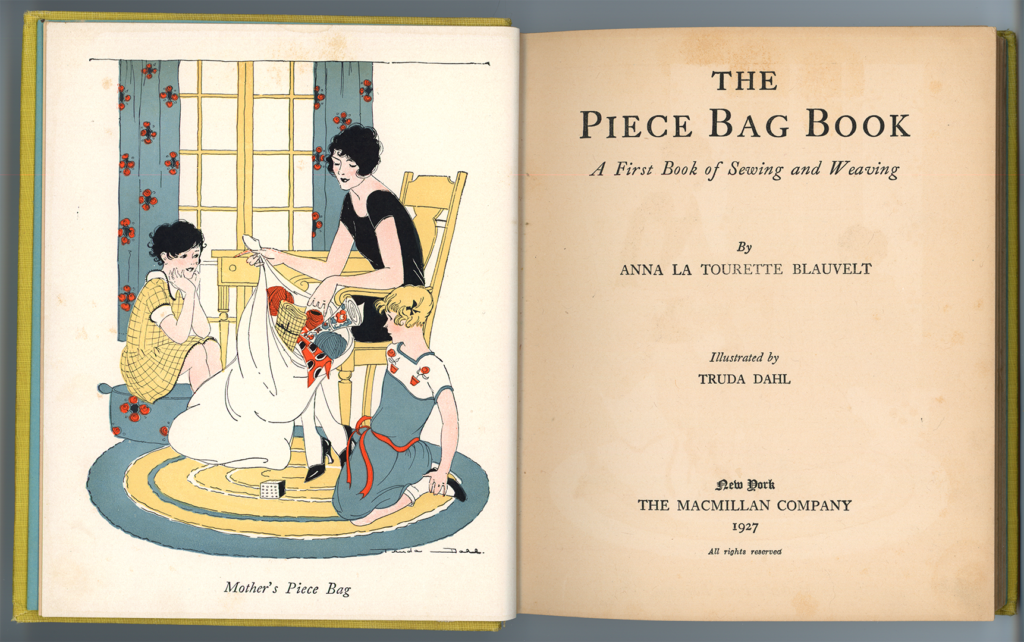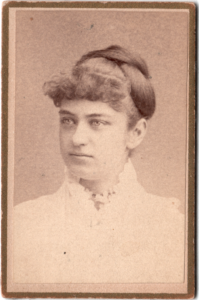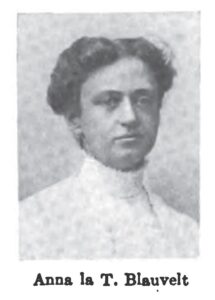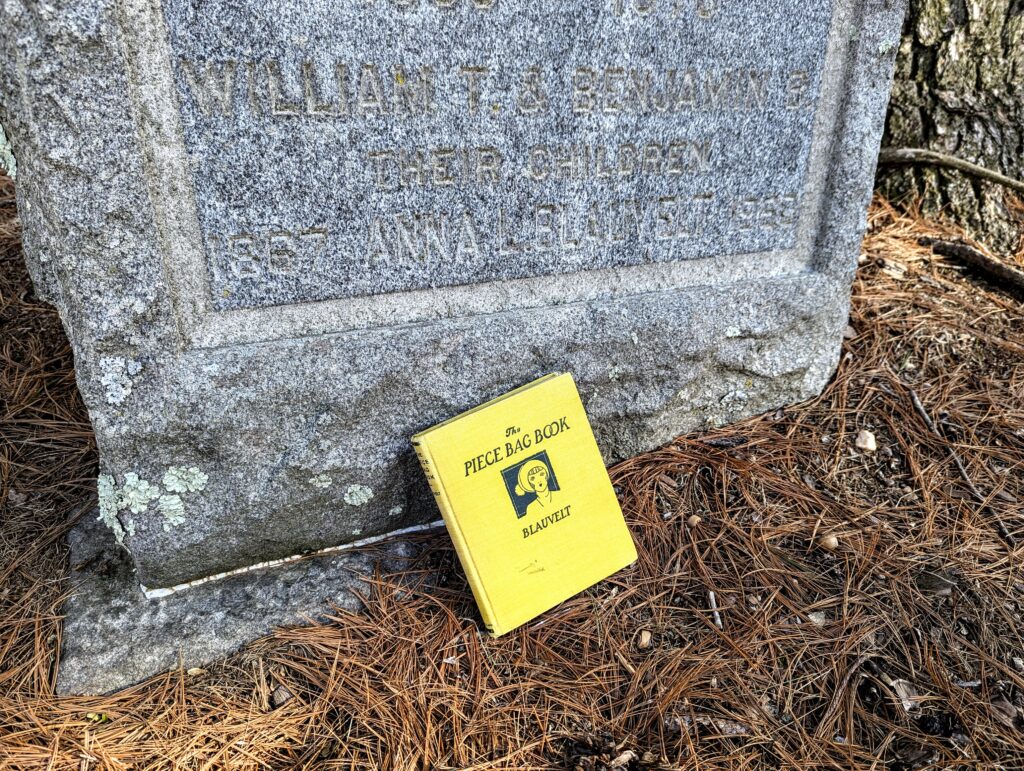Tags
1920s, 19th Century, 20th Century, asylums, blauvelt, blithewood, education, genealogy, new jersey, ulster county
One of my favorite things to do as a local history researcher is to bring forgotten people to light once more. This is one of many such stories, initiated by a single photograph.
I inherited a collection of hundreds of photographs from my Losee grandparents, mostly 19th- and 20th-century portraits of relations, but a handful are images of friends of the family. When I was a teenager, I took some of these unlabeled or unrelated photos and used them in artworks, suspended between glass and felt in antique picture frames surrounded by colorful Victorian cutouts.
Recently, I needed a frame and carefully reunited the cutouts and photos with others in my collection. As I examined the photos from the piece, I noticed that I had done myself a favor—I noted on a slip of paper that they were originally found in a Knickerbocker/Sharpe family album; even as a teen I realized it was important to record provenance. One of them was a “miniature print” of a young woman with 1890s curled bangs. Not only was there the photographer’s name and location, but a name written in pencil on the reverse.
Almost 30 years have passed since I put the images in that frame in the late 1990s. It would have been an uphill battle to find someone unrelated with only a name and a possible connection to my family to go on if I had been a researcher at the time. In 2024, taking the first steps to discovering who this was took me about three hours to accomplish.
Anna La Tourette Blauvelt was born in 1867, possibly in Ulster County, NY, to Augustus Blauvelt of Seneca County, NY and Jane Zabriskie of Hudson County, NJ. Anna’s father attended Rutgers and seminary school in New Brunswick, NJ. He married Jane Ackerman Zabriskie* (also known as Mary Jane or Jennie), daughter of Albert Michael Zabriskie and Ann MacIntyre La Tourette of Bayonne, NJ. Augustus and Jane had at least two children that survived to adulthood, Anna and her brother Albert A. Blauvelt, as well as two boys who died young, Benjamin B. and William T. Blauvelt. Augustus was a man of the cloth, and the couple traveled to China for missionary work in the early 1860s. Due to Jane’s poor health they returned to the US in late 1864. [*I could not determine if Jane was in any way related to Andrew C. Zabriskie, of Blithewood (now a part of Bard College). There were a great many people with that surname in New Jersey in the 19th century]
Anna’s mother Jane and brother Benjamin both died in April of 1870. When the census was taken for that year her father Augustus and brother Albert were living together in Rosendale, Ulster Co., NY where Augustus was a minister. Court records tell us he was appointed the guardian of his two children in 1873 with “his mother-in-law going on his bond”. Proving this, we find three-year-old Anna recorded in her grandmother Ann Zabriskie’s home in Bayonne in 1870 when the census was taken.
Augustus published Christian articles in newspapers and journals, some of which put him at odds with the Reformed Church he represented such that they saw fit to depose him of his duties in 1877 for heresy. A year later, a fit of public madness caused him to be committed to the New York State Hospital in White Plains, NY, then to Hudson River in Poughkeepsie where he remained for many years. Finally, he was transferred to Binghamton where he died in 1900. He suffered paranoid delusions and believed that “enemies”, such as “liquor dealers” he believed he’d angered with his temperance writings, were trying to harm him. In another case of mental illness in the family, Anna’s brother Albert would dramatically take his own life in 1918 for unknown reasons.
Despite the lack of supportive parents, Anna found a path for herself through education. As a child, she attended the Kingston Academy in Kingston, Ulster County, NY, graduating at 18 years of age in 1885. At her graduation, Anna read the salutation, and it was remarked she shared “highest honors” with another boy in her class. She then went on to study art and art instruction at the Sorbonne in Paris and at the Pratt Institute Teachers College in New York City where she was a pupil of Arthur Wesley Dow. She became a teacher of “manual” or “industrial” art which included trade work, such as mechanical drawing and handwork, such as basket weaving, embroidery, and sewing.
In 1905 Anna resided with widow Sarah Hawley and her daughter, fellow teacher Mary, in Nutley, NJ but removed to Oakland, California sometime before 1908 to teach there. She contributed articles to trade journals such as School Arts Magazine starting as early as 1911. In 1914 she became the Director of Manual Arts at North Arizona Training School in Flagstaff.
Anna received a B.S. in education from Columbia teacher’s college in 1915 and spent at least the month of June living with her uncle, Albert Zabriskie in Rosendale, where she visited with old friends and attended her high school reunion. She taught summer school in Missouri, at Rutgers, Columbia, and the University of Vermont, Montpelier. While living in Morningside Heights near Columbia in the 1920s she served as secretary to the Industrial Arts Co-operative Service—an organization established to inform teachers of new ideas for instructing children in arts and crafts.
In 1927, Macmillan published The Piece Bag Book, A First Book of Sewing and Weaving written by Anna La Tourette Blauvelt and illustrated by Truda Dahl, a small, hardcover “work and play” book that “encourages little girls to learn to sew by suggesting things that they can make for their dolls and their playhouses”. At the time of publication her book was part of the “Work and Play” series of books, including four other titles by other authors: Your Workshop, With Scissors and Paste, and Playing with Clay.

First illustration and title page of The Piece Bag Book by Anna La Tourette Blauvelt, Macmillan, 1927
The book illustrates the needlework and weaving projects of two little girls called Teddy and Eleanor. Guided by their mother, the girls create simple things like a hat, scarf, pompoms, tablecloth, and a bedspread from fabric and trim scraps found in the mother’s titular piece bag. The narrative begins with the children wanting something fun to do on a rainy day and gives instructions to the young reader on how to make each item, as well as a brief note to parents at the back as to what supplies to have on hand. The children’s dialog is written in cute, century-old vernacular and the instructions are clear and simple to follow as such an instructional book should be.
The 1930 census recorded Anna living in her own apartment close to Columbia with many professors and teachers as neighbors. She was listed as single, 62 years old, born in New York with a father born in New York and mother born in New Jersey, and her occupation was public school teacher. If the building numbers today are not all that different from what they were in 1930, she lived within walking distance of PS 125.
When the 1940 census was taken, Anna had reached the age of 72 and was a resident of a “Home for Aged Women”, specifically, the Miriam Osborn Home in Harrison, NY. She was in the same place in 1950. The data recorded about her in the census doesn’t exactly line up, but one can imagine that it was tough to get accurate information owing to the nature of the facility and her place in it.
In the 1950s, two of Anna’s first cousins, twice removed, contacted Elmwood Cemetery in North Brunswick where their family had a plot to make sure that when the time came, there was a place for Cousin Anna’s remains. One of them wrote in 1958 that “at present she seems quite well although she is 90 and senile.” The cousins were Margaret “Madge” Zabriskie Pockman Van Zanten 1885-1967 and her sister Eleanor Alling Pockman 1888-1971 who were daughters of Anne La Tourette Boice Pockman, a daughter of Margaret Zabriskie Boice, who was a daughter of Albert Zabriskie, who’s sister Jane Zabriskie was Anna’s mother. It was very kind of them to go to such lengths to make sure she found her way back home.
Educator Anna La Tourette Blauvelt passed away on March 18th, 1960, and her remains were interred in Elmwood Cemetery, her name and dates are engraved on the tombstone she shares with her parents and brothers.
Sources:
- 1860 Federal Census, Bergen Point, Bergen, Hudson Co NJ – Albert M Zabriskie
- 1860 Federal Census, Covert, Seneca Co NY – Mary Blawvelt
- 1870 Federal Census, Bayonne, Hudson Co NJ June 24th – Ann Zebriskie
- 1870 Federal Census, Rosendale, Ulster Co NY – Cornelius Schoonmaker
- 1875 New York State Census, Kingston Ulster Co NY – Ann E Fort
- 1880 Federal Census, Poughkeepsie, Dutchess Co NY, Hudson River State Hospital – Augustus Blauvelt, inmate
- 1892 New York State Census, North Hempstead, Nassau Co NY – Albert A Zabriskie
- 1900 Federal Census, Monmouth Co NJ – Albert Zabriskie
- 1905 New Jersey State Census, Nutley, Essex Co NJ, Whitford Ave – Sarah E Hawley
- 1910 Federal Census, Berkeley Alameda Co CA – Anna L Blauvelt
- 1915 New York State Census, Rosendale, Ulster Co NY – Albert E Zabriskie
- 1925 New York State Census, Rosendale, Ulster Co NY – Albert A Zabriskie
- 1930 Federal Census, Manhattan, New York Co NY #540 W 123rd st Anna Blauvelt
- 1940 Federal Census, Rye, Westchester Co NY Osborn Memorial Home for Aged Women – Anna L Blauvelt, inmate
- 1950 Federal Census, Rye Westchester Co NY – Osborn Memorial Home for Aged Women – Anna Blauvelt
- Alameda County Manual of Statistics and Information, 1908 page 67.
- Albany School of Fine Arts announcement pamphlet, 1911, page 5
- Barnard Bulletin, 5 Oct 1923
- Blauvelt, Anna La Tourette. The Piece Bag Book. Macmillan, NY, NY 1927
- Catalogue of Officers and Graduates of Columbia University (teachers college) XVI edition, NY 1916
- Chicago Tribune, 8 October 1908
- Coconino Sun, Flagstaff AZ 30 Jun 1911
- Columbia University 161st commencement book, published 2 Jun 1915
- Cummings, Carole Elizabeth Nurmi, research by Find-a-Grave contributor 47178231
- Elmwood Cemetery, North Brunswick, NJ Burial Files
- Evening Star, Washington, D. C. 5 January 1918, Page 11 “Albert Blauvelt Sad Death”
- findagrave.com/memorial/261220356/albert_m_zabriskie
- findagrave.com/memorial/261221067/ann_mcintyre_zabriskie
- findagrave.com/memorial/261260783/augustus_blauvelt
- findagrave.com/memorial/261318776/albert_a_blauvelt
- findagrave.com/memorial/47071723/anna-la_tourette-blauvelt
- findagrave.com/memorial/47071812/margaret-ann-boice
- High School Teacher, The magazine Vol III No 1
- House & Senate Journals 48th Gen Assem. State of Missouri V II 1915 – Salary appropriated for teachers and officers
- Industrial Arts Magazine Vol VII No 11 November 1918 p. 424
- Kingston Daily Freeman, 10 Jun 1915
- Kingston Daily Freeman, 11 Jan 1918 Local Death Record
- Kingston Daily Freeman, 17 Jan 1950
- Kingston Daily Freeman, 20 Jul 1920
- Kingston Daily Freeman, 22 Jun 1913
- Kingston Daily Freeman, 25 Jun 1915
- Kingston Daily Freeman, 30 Jun 1916
- National Parent-Teacher Magazine, The Sep 1928
- New York Daily Tribune, 27 Jun 1885
- New York Herald, 2 Jul 1878 p. 8 “AN INSANE CLERGYMAN”
- New York State Death Index, certificate #24097 Anna L Blauvelt
- New York Tribune, 3 May 1870 p.5
- Oakland, California city directory, 1909
- Playground and Recreation Association of America Magazine Vol XXI no 1, April 1927
- Progressive Education magazine Vol III No 1 Jan-feb-mar 1926 Industrial Arts Co-operative Service
- San Francisco Chronicle, 5 Sep 1909
- Santa Ana Daily Register, 16 Nov 1927
- School Arts Magazine Vol XII No 9 May 1914 page 664
- School Arts Magazine Vol XXV No. 6 Feb 1926 p. 339
- Seattle Union Record, 14 Dec 1927
- SUNY 109th annual report of Regents 1895 admin department vol 2 Academies. Transmitted to the legislature 11 Feb 1886, Albany 1897-1893 University of the State of NY – Erasmus Hall Academy, Flatbush. Faculty
- University of Vermont, Montpellier bulletin, Vol XIX No 6 1921-1922






